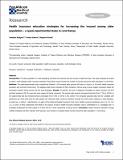| dc.contributor.author | Nyagero, Josephat | |
| dc.contributor.author | Gakure, Roslyn | |
| dc.contributor.author | Keraka, Magaret | |
| dc.date.accessioned | 2021-08-31T12:55:06Z | |
| dc.date.available | 2021-08-31T12:55:06Z | |
| dc.date.issued | 5/13/2012 | |
| dc.identifier.citation | Nyagero J, Gakure R, Keraka M. Health insurance education strategies for increasing the insured among older population - a quasi experimental study in rural Kenya. Pan Afr Med J. 2012;12:9. Epub 2012 May 13. PMID: 22826733; PMCID: PMC3396875. | en_US |
| dc.identifier.issn | 1937-8688 | |
| dc.identifier.uri | http://repository.amref.org/handle/123456789/188 | |
| dc.description | © Josephat Nyagero et al. The Pan African Medical Journal - ISSN 1937-8688. This is an Open Access article distributed under the terms of the Creative Commons
Attribution License (http://creativecommons.org/licenses/by/2.0), which permits unrestricted use, distribution, and reproduction in any medium, provided the original
work is properly cited. | en_US |
| dc.description.abstract | Introduction: The older population in most developing countries are uninsured and lack access to health services. This study assessed the extent
to which a multi-strategy health insurance education intervention would increase the number of insured among the older population in rural Kenya.
Methods: The quasi-experimental study prospectively followed 1,104 unpaired older persons (60 years or more) in a 10-month health insurance
education and enrolment intervention. The adjusted odds ratios computed at 95% confidence interval using a binary logistic regression tested the
association between being insured and the multi-strategies. Results: At baseline, the lack of adequate knowledge on health insurance (52.9%)
and high premiums (38.1%) were the main reasons for being uninsured. The insured older persons increased three-fold (from 7.7% to 23.8%) in
the experimental site but remained almost unchanged (from 4.0% to 4.6%) in the control. The computed adjusted odds ratio for variables with
significance (p<0.05) show that the older people who obtained health insurance education through the chief’s public meeting, an adult daughter,
an adult son, a relative - sister/brother, an agent of the National Hospital Insurance Fund, and a health insurance beneficiary were 2.6, 4.2, 2.8,
2.3, 2.5 and 2.5 times respectively more likely to be insured. Access to health insurance education using a combination of 1-3 strategies and >3
strategies predisposed the older people 14.3 times and 52.2 times respectively to being insured. Conclusion: Health insurance education through
multiple strategies and their intensity and frequency were pivotal in increasing being insured among the older population in rural Kenya. | en_US |
| dc.description.sponsorship | African
Doctoral Dissertation Research Fellowship (ADDRF) through the African Population and Health Research Center (APHRC) in partnership with IDRC
and Ford Foundation | en_US |
| dc.language.iso | en | en_US |
| dc.publisher | Pan African Medical Journal | en_US |
| dc.subject | Insured | en_US |
| dc.subject | Uninsured | en_US |
| dc.subject | Older population | en_US |
| dc.subject | Health insurance | en_US |
| dc.subject | Education | en_US |
| dc.subject | Multi-strategies | en_US |
| dc.title | Health insurance education strategies for increasing the insured among older population – a quasi experimental study in rural Kenya | en_US |
| dc.type | Article, Journal | en_US |

